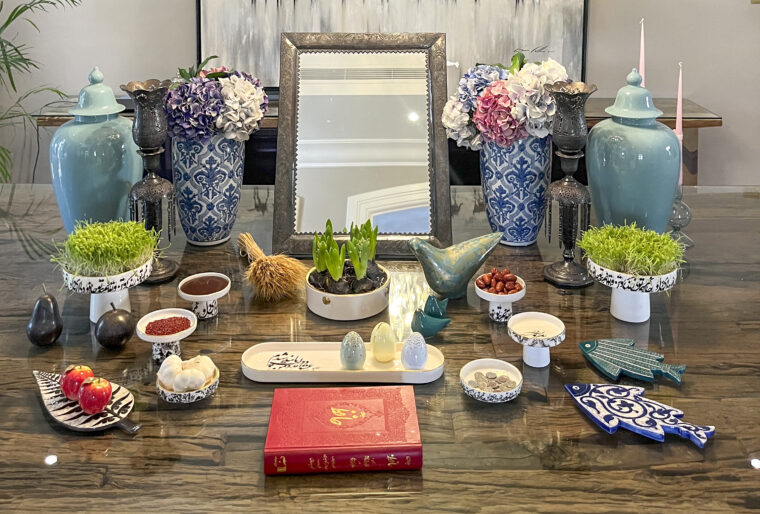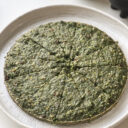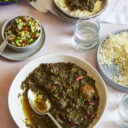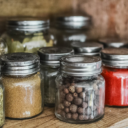As spring approaches, I can’t help but feel excited to celebrate Nowruz, the Persian New Year. It’s a time when millions of people around the world come together to honor their cultural traditions and values. This joyous occasion is marked by a range of cultural traditions, all of which reflect the cultural values and beliefs of the Persian-speaking world.

Haft-Seen
One of the most important traditions associated with Nowruz is the setting of a haft-seen table. Haft seen is a Persian term that means “seven S’s,” referring to seven specific items that begin with the letter “S” in the Persian alphabet. Each item on the table holds a special significance and meaning, reflecting the values and beliefs of the Persian-speaking world. Here is a closer look at each of the seven items that make up the haft seen table:
- Sabzeh (Sprouts or Grass) – Sabzeh is a dish of sprouts or grass, usually wheat, barley, or lentil, that represents growth and rebirth. The sprouts are often grown in a decorative dish and kept on display throughout the Nowruz celebrations. Sabzeh symbolizes the renewal and regeneration of nature, and the promise of new beginnings.
- Seeb (Apple) – Seeb, or apples, represent beauty and health. Apples are believed to have healing properties, and they also symbolize the abundance of the natural world. In some traditions, apples are cut and eaten as a way of sharing the blessings of the new year with loved ones.
- Serkeh (Vinegar) – Serkeh, or vinegar, represents patience and wisdom. Like vinegar, which is made through a slow and steady process of fermentation, wisdom and patience are qualities that must be cultivated over time. Vinegar also represents the sour moments of life, which are necessary for balance and growth.
- Samanu (Sweet Pudding) – Samanu is a sweet pudding made from wheat germ that symbolizes wealth and fertility. Samanu is made through a long and labor-intensive process, representing the value of hard work and perseverance. The sweet taste of samanu is a reminder of the sweetness of life, and the abundance that can come from cultivating good habits and virtues.
- Senjed (Dried Fruit) – Senjed, or dried fruit, represents love and affection. In some traditions, the dried fruit used in the haft seen table is from a lotus tree, which is believed to have healing properties. Senjed is also a symbol of the sweetness and nourishment of love, and the importance of cultivating strong relationships with family and friends.
- Sir (Garlic) – Sir, or garlic, is a symbol of medicine and health. Garlic is believed to have many health benefits, and it has been used for medicinal purposes for thousands of years. In some traditions, garlic is also associated with warding off evil spirits and negative energy.
- Somagh (Sumac) – Somagh, or sumac, is a spice that represents the color of sunrise and the victory of good over evil. Somagh is a key ingredient in many Persian dishes, and it is often used to add a tangy, citrus-like flavor to food. The deep red color of sumac is also associated with the rising sun, which symbolizes new beginnings and the triumph of light over darkness.
In addition to these seven items, many haft seen tables also include other decorations and symbols, such as candles to represent enlightenment, a mirror to symbolize reflection and self-awareness, and goldfish to represent life and movement.
The haft seen table is a beautiful and meaningful way to celebrate the arrival of spring and the start of the Persian New Year. Each item on the table represents a different aspect of life and the natural world, reminding us of the importance of gratitude, balance, and community. By setting a haft seen table and participating in other Nowruz traditions, we can connect with our cultural heritage and honor the traditions of the Persian-speaking world.
Another important tradition associated with Nowruz is the exchange of gifts. During this time, families and friends give each other presents as a symbol of their love and appreciation. These gifts are often related to the haft seen table, such as books of poetry, coins, or items made from silver or gold.
FOOD
Food is an important part of the Nowruz celebrations, and there are several traditional dishes that are commonly served during this time. Many of these dishes have symbolic meanings, representing the abundance and renewal of the new year.
One of the most popular dishes for Nowruz is sabzi polo mahi, which is a fragrant rice dish served with fish and a variety of herbs. The fish symbolizes fertility and abundance, while the herbs represent growth and rebirth. Another traditional dish is kookoo sabzi, a herb-filled omelette that is often served for breakfast during the Nowruz period.
Another popular dish is ash-e reshteh, a thick soup made from beans, lentils, and noodles. This dish is often served on the thirteenth day of Nowruz, which is known as Sizdah Bedar, a day when families traditionally gather for a picnic and spend time outdoors.
Desserts are also an important part of the Nowruz celebrations, with many families serving sweets and pastries to mark the occasion. One popular dessert is halva, a sweet paste made from sesame seeds that is often served with nuts and dried fruit. Another popular dessert is baklava, a flaky pastry filled with honey, nuts, and spices. Whether you’re cooking traditional recipes passed down from generations or trying out new and modern dishes, the food served during Nowruz is a symbol of the joy and abundance of the new year.
Noruz Suggested Recipe
FESTIVE TRADITIONS
Nowruz is also a time for participating in cultural events and festivities. This may include attending parades, concerts, or traditional dances. It’s an opportunity to connect with friends and family, meet new people, and celebrate the diverse cultural traditions of the Persian-speaking world.
Nowruz reflects the cultural values and beliefs of the Persian-speaking world, particularly the importance of family and community. It’s a time to come together, share stories, and connect with loved ones. This sense of community and togetherness is also reflected in the haft seen table, which represents the diversity and beauty of the natural world. If you’re interested in celebrating Nowruz, here are some tips to help you get started:
- Set a haft seen table: Follow the traditional guidelines for setting a haft seen table, or create your own variation that reflects your personal style and preferences.
- Exchange gifts: Consider giving gifts to loved ones, or hosting a gift exchange with friends and family.
- Attend cultural events: Look for cultural events in your local community, or consider attending a Nowruz celebration in a nearby city.
- Incorporate sustainable practices: Choose organic and locally sourced ingredients for your haft seen table, and use reusable or recycled materials for decoration and packaging.
- Learn more about Persian culture: Explore Persian art, music, literature, and history, and share what you learn with others.
Nowruz is a time of renewal and rebirth, a celebration of the natural world and the power of community. Whether you’re a member of the Persian-speaking world or simply interested in exploring new cultural traditions, this is a festive occasion that’s sure to bring joy and meaning to your life. We encourage you to celebrate Nowruz with your family and friends, and to learn more about the rich cultural heritage of the Persian-speaking world.




